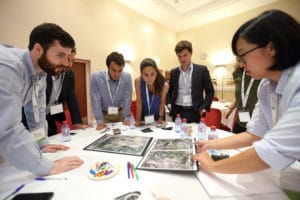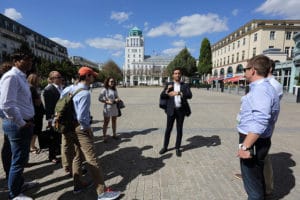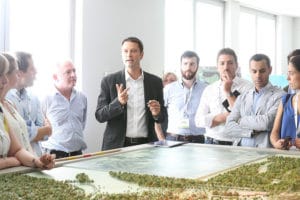Top Story
The 2016 ULI Young Leaders Summer School took place in Paris, France. The theme was urban planning and investment, with a focus on Paris as one of the largest real estate markets in Continental Europe. Attendees heard insights from key experts and current case studies on how to plan, design, build and access investment, including a site tour of Val d’Europe as an example of a public and private partnerships.
View Programme See Who Attended ULI Member Directory
Day 1: An in-depth look at Val d’Europe
by Ashley Perry, Senior Project Manager, JLL
 Nearly 40 Young Leaders from across Europe arrived at Disneyland, from more than 10 countries, with even a handful of the 2015 Brussels Summer School attendees meeting once again.
Nearly 40 Young Leaders from across Europe arrived at Disneyland, from more than 10 countries, with even a handful of the 2015 Brussels Summer School attendees meeting once again.
Emmanuel de Lanversin, Chair of ULI France and Directeur Général Délégue of SemiPariSeine warmly introduced the Young Leaders Summer School. His chairmanship of ULI France has enabled the local Young Leaders group to successfully arrange this year’s event. As de Lanversin quipped: there are doers and thinkers in the world of real estate development – for a few days, we were encouraged to think rather than do.
The event began with a whistlestop visual tour of the Val d’Europe development and the wider vision for the area that includes Disneyland Paris. Phase 1 of the area’s development began in 1989 and Phase 4 began in 2014. It truly is a mega-project. It is Europe’s number one tourist destination and an essential part of the French economy.
We heard senior leaders from the likes of Euro Disney, Marne-la-Vallée, Value Retail and Warimpex explain the facets of the development that make it a true mixed-use success. All of the companies have a shared interest in the success of the area and the fascinating statistic that the development of the 2,230 ha site at Euro Disney has only just begun gives a sense of the pipeline of opportunities and challenges that the team has.
A detailed summary of the architectural philosophy from Bernard Durand-Rival, Chief Architect and Urbanist, EuroDisney, helped to shape our understanding of the development while he also shared the future plans for the area. The Q&A brought an interesting perspective on Euro Disney’s aims to market to German and Middle Eastern visitors also driving their ambition to make it a place for all ages.
After a brief networking break, Sarah Zouheir, Societé du Grand Paris, shared the Grand Paris vision – many of the attendees from February’s Young Leaders Forum were familiar with this – and the project was likened to London’s Crossrail development for its revolutionary impact on urban connectivity and also investment opportunities. Grand Paris will ensure that the vital cultural and music venues are better connected for Parisians and visitors.
A number of the key Val D’Europe team members shared their expertise during the development workshop with attendees split into groups to share their vision for an opportunity near the main entrance of the Disneyland park. Again, this was an opportunity for the doers to think. The winners presented a mixed-use proposal including a market, event space, and, with a Walt Disney level of imagination, a cable car system connecting the park. Ari Erlichman, Senior Manager Resort Development at Euro Disney, presented the winning team members with two tickets to Disneyland so they can all return again soon. The interactive workshop was a fascinating session and, in true ULI multi-disciplinary style, showcased the mix of perspectives that the Young Leaders group is proud of.
Day 1: Site Tours
by Tomek Aleszczyk, Investment Associate, Kulczyk Silverstein Properties
 Our site tours on day one started with a visit at the main office of the Village Natur Project. Francois Mary, responsible for investor relationships, introduced us to a 280 hectare hospitality complex located few kilometres south of Disneyland.
Our site tours on day one started with a visit at the main office of the Village Natur Project. Francois Mary, responsible for investor relationships, introduced us to a 280 hectare hospitality complex located few kilometres south of Disneyland.
The project will consist of up to 1,700 units spread around artificial lake. An aquatic centre and promenade with 10,000 sq m of boutiques, shops and restaurants will become the heart of the village. In addition, a magical garden and farm will deliver an extraordinary experience for children. This development also includes a specious pedestrian and cycling area with very restricted car traffic. Guests will not have to worry about expense tracking as all transactions will be recorded on wrist bands and processes upon the end of the stay.
The project sets itself apart from mass market complexes in the area and is definitely noteworthy. On the other hand, it could be characterised as simply a modern and luxury variation of the common campsite. One thing is certain: being closer to nature is the future of tourism.
Our second viewing was split into two parts: a look at the development of the second phase of the Val d’Europe shopping centre and a tour of the luxury outlet shopping centre, La Vallée Village.
Both shopping centres are located next to each other, at a walking distance from an RER station. Val d’Europe is a typical shopping centre with 160 retail units addressed to a broader mass market client base. Regis Hugo, project manager, presented the newest part of the project with an astonishing roof inspired by the Grand Palais. Under this amazing dome, around 35 new retail brands will open their boutiques in 2017.
La Vallée Village is an absolutely different concept. Each of the premium or luxury brands has a detached unit with an entrance from the outside sidewalk. Allison Ensigne from the marketing department explained how important this separation is in creating brand identity. Thanks to its proximity to public transport, up to 6 million tourists visit this retail centre yearly. 93% of customers come from Asia, and China in particular.
Day 2: Public-private partnerships and macroeconomics
by Emilie Walker, Executive Analyst, Grosvenor Britain & Ireland
 After dancing the night away at Billy Bob’s Country Western Saloon in the Disney Village, a few of us were glad to have an extra half hour, and perhaps an extra espresso or two, before the day started!
After dancing the night away at Billy Bob’s Country Western Saloon in the Disney Village, a few of us were glad to have an extra half hour, and perhaps an extra espresso or two, before the day started!
First up, we had Salim Bensmail, Director at the French Infrastructure Finance Unit, providing a thorough lesson on Public Private Partnerships (PPPs). The most common structure in France is through concessions where the private sector takes on the risk and receives a return from user fees. Apparently, these have been used since Napoleonic times. An alternative structure provides public payments to the private investor, funded by taxes.
Worldwide, there is a love-hate relationship with PPPs. Certain countries (Canada, UK, Japan) and organisations (Word Bank, OECD, UN) profess the benefits of PPPs. Many of the global institutions are separately working on guidelines for PPPs; however, there is not one standard currently underway, which Salim highlighted as a potential issue. On the more negative view towards PPPs, Salim noted the French amended the constitution in 2003 to restrict conditions for the partnerships to be used. Until this year, complexity and urgency had to be demonstrated in order to proceed.
PPPs are different from traditional contracts in that they are long-term, including the costs of financing and maintenance, in addition to construction. This provides cost efficiencies and transparency; however, in this changing world, do you really want a perfect asset in 20 years, just as it was at day one? Perhaps asset flexibility is better and there could be over-investment in the maintenance of some public buildings.
To conclude, Salim challenged the audience of young real estate professionals: do private companies actually manage their assets the way they argue the public authorities should manage their own?
Our second and final conference session covered several macroeconomic and property questions and encouraged audience participation. Simone Pozzato, Transactions Manager at Grosvenor Europe, posed questions to Jaap Tonckens, Chief Financial Officer at Unibail-Rodamco and Guillaume Turcas, Head of Asset Management Offices, AEW Europe.
Brexit was a major topic. Both agreed that London will not lose its first place, but they are modelling many scenarios for the next few years. This time around, there is much less leverage in the system, so there should be much less forced selling. If passporting is not permitted, then firms may require subsidiaries in the continent.
For the office market, Guillaume noted that the continental Europe markets were all recovering well, particularly in the last 12-18 months. Not only location, but quality is important for talent attraction and retention. Jaap echoed that the expectations of younger works matter and are fundamentally evolving office buildings: balconies on every floor, hang out areas, and a place for fun.
The threat of e-commerce for retail was not a concern for the panellists. Most online shopping is commodities or purpose-driven and people want to go to shopping malls for leisure. It may be that the best shopping centres will simply take the market share from the “boring centres”. For retailer success, on and offline presence must be seamless.
After a tasty lunch with plenty of sunshine we said goodbye to Disneyland and transferred to Paris on the RER for our final site tour.